You are here
Preservation
One of the fundamental responsibilities of any historical records repository is to ensure that the records in its collections are available in their original format for as long as possible. Ensuring your records are well preserved involves more than stabilizing your environment and storing your records in preservation quality containers. A robust preservation program also includes a system for securing your records from theft, a disaster response plan and procedures for handling records.
While the complexity and cost of preserving records can be intimidating, focusing your efforts on many low-cost incremental improvements will noticeably impact the condition of the records in your care. Consistent small improvements in your preservation program will not only benefit the records in your care but will increase your credibility in the eyes of donors and your governing body. In many cases grant funds can support the expenses involved in improving your preservation program. In particular grants from the New York State Library, the National Endowment for the Humanities and Heritage Preservation support preservation projects.
Whatever actions you choose to undertake should be part of an overall preservation management plan that coordinates environmental monitoring and management, storage conditions, security planning, and disaster planning.
In this section you will assess the following:
Building and Environment
Building

Window repair at Half Shire Historical Society, Richland, NY
The first line of protection for your historical records is your building. A well maintained and regularly inspected building will protect your records from water damage from leaky roofs or fire damage from an outdated electrical system. Budgeting for and performing regular maintenance on your building will prevent costly repairs and provide a good home for your collections. Establishing a good working relationship with your building maintenance staff is essential to ensuring your building is consistently maintained.
Environment
The ultimate goal of any historical records repository is to preserve records of enduring value in their original state and make them available for research. All historical records are prone to deterioration that causes paper to become brittle, photographs to fade, and book bindings to crack. The most effective means of preventing your materials from rapidly deteriorating is to store them in a dedicated storage facility with a controlled environment. Avoid attics and basements when deciding where to locate your storage area. Attics are generally too hot and basements too damp for storing historical records.
Temperature, relative humidity, lighting, and air quality all affect the longevity of your historical records. Generally the cooler your environment the better it is for your records. Ideally, the maximum temperature in your storage facility is 70 degrees Fahrenheit with a relative humidity between 30% and 50%. You run the risk of mold growth if your relative humidity levels are consistently over 65%. Temperature and relative humidity should be kept as stable as possible with only gradual fluctuations. While it may not be possible for your repository to maintain these precise levels it is important to provide as stable an environment as possible.
In addition to controlling temperature and relative humidity you should limit the time records are exposed to light by covering windows, avoiding fluorescent lighting, and turning lights off in your storage facility whenever possible. Keeping records in preservation quality containers will also limit their exposure to light.
Protect your collection from possible fire damage through the use of fire detection and suppression equipment. You can opt to use a variety of fire suppression systems to protect your records but you should make sure they conform to local building and fire codes.
While it may not be possible to immediately establish an ideal preservation environment for your collections, consistent, incremental improvements in monitoring, and regulating your environment will dramatically increase the longevity of your collections.
Housekeeping
Boxes and shelves in your storage area should be regularly cleaned with untreated electrostatic dust cloths to remove and dirt and dust that may accumulate. Floors should be dry mopped to avoid the fluctuations in humidity that conventional wet mops can cause. Chemical cleaners including treated dust cloths and mops should not be used near historical records. It is important to set up a regular cleaning schedule and set aside regular intervals in your schedule to clean your storage area.
Pest Control
Your historical collections can attract pests that will damage paper and other materials in your custody. Maintaining a stable environment, prohibiting food and drink from your repository, and regularly cleaning your storage area and offices will reduce your risk of infestation from potentially harmful pests. Combining these activities with regular monitoring procedures designed to identify pests will limit the need to apply chemical pesticides that can harm your collections, staff and users. Pesticides should only be used in your repository as a last resort to treat ongoing infestations not as part of regular prevention.
Benefits
- Ensures records are preserved and are well protected.
- Provides broadest preservation benefits for all records in your collection.
- Increases confidence of donors and records creators in repository’s ability to protect valuable records.
Standards and Best Practices
- NEDCC Preservation Leaflet 2.1 Temperature, Relative Humidity, Light and Air Quality: Basic guidelines for Preservation
- International Council of Archives Bibliography of Books, Journal Articles, Conference Papers and Other Printed Sources Relating to Archival Buildings and Equipment
- Documentary Heritage and Preservation Services for New York (DHPSNY) Introduction to Integrated Pest Management Webinar
- SAA Archival and Special Collections Facilities: Guidelines for Archivists, Libraries, Architects and Engineers Society of American Archivists (2009)
- Thomas Wilstead Planning New and Remodeled Archival Facilities Society of American Archivists (2007)
- Image Permanence Institute IPI’s Guide to Sustainable Preservation Practices for Managing Storage Environments
Security
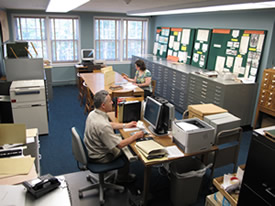
Reading room, New York Historical Association, Cooperstown, NY
Security planning for your repository is a process of striking a balance between providing access to historical records, while protecting those records from theft or vandalism. Theft of historical records is becoming increasingly prevalent and you need to commit appropriate resources to protect your collections. Smaller repositories are often targeted by thieves because they are commonly unable afford the staff or resources to provide security. Protecting your collections does not always require large financial investments and there are a number of steps you can take to secure your collections.
Consider the following elements when developing your security plan.
- Control Access. Whenever possible physically separate your locked storage areas from office space and research rooms. Researchers and other visitors should not have access to your storage space. Staff should only access your storage area when there is a demonstrated need. Maintain a key inventory.
- Document Your Collections. Accession records, deeds of gift, finding aids, and catalog records establish ownership of your materials and prove they are missing from your collection after a theft.
- Manage Use. Establish procedures for documenting who uses your collections, what records they use, and when they used them. Monitor researchers at all times and do not leave them alone with your historical materials.
- Human Resources. You should have safe procedures for hiring, training, and managing staff and volunteers. Set regular work hours and do not allow staff to work before or after hours.
- Education and Training. Review your security procedures and seek out opportunities for training in library and archives security.
- Who steals? Be aware of the prevalence of theft by staff, volunteers, researchers and individuals authorized to use your collections.
While it is impossible to completely protect your collection from theft, a well developed security plan can reduce the risk of theft, speed the recovery of stolen materials, and demonstrate your repository’s commitment to responsibly managing historical records.
Benefits
A security plan:
- Allows appropriate use of your collections while protecting them from theft or vandalism.
- Assists your organization when responding to a theft in your repository.
- Protects staff who regularly works with documents by establishing safeguards for accessing historical records.
- Demonstrates your repository’s due diligence.
Standards and Best Practices
- ACRL/RBMS Guidelines Regarding Security and Theft in Special Collections
- Getty Conservation Institute Collections Theft Response Procedures
- New York State Archives Historical Records Theft: Strategies for Prevention and Response
- Gregor Trinkaus Randall Protecting Your Collections: A Manual of Archival SecuritySociety of American Archivists (1995)
- Robert K O’Neil Management of Library and Archival Security: From the Outside Looking In. Routledge, 1988.
Disaster Planning
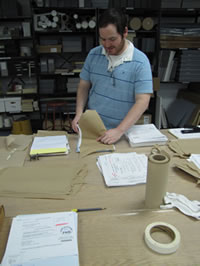
Disaster recovery workshop
Albany County Hall of Records,
Albany, NY
What happens if a fire breaks out in your repository? Does your staff know how to respond to a flood, hurricane, or earthquake or if a water pipe breaks near your stacks? While we never want any of these events to occur, a disaster plan will help you protect your staff and collections in the event of most disasters.
A disaster plan is a written plan that
- Identifies potential risks to your collection including natural and man-made disasters, and any mechanical problems with your building.
- Includes lines of authority and contact information for repository and maintenance staff as well as emergency fire, police and ambulance services.
- Outlines emergency response and salvage procedures including the location of supplies required for immediate response.
- Identifies especially valuable or vulnerable collections that will receive priority treatment in the event of a disaster.
Disasters can range in severity from a tornado to a leaky water pipe and it is important your plan is flexible enough to deal with a variety of possible emergencies. Regardless of the severity of the disaster, no one should risk personal safety to protect your collections. Your first priority in any disaster is to ensure you, your staff and researchers are safe. The more detail you include about lines of authority and response procedures, the less time you and your staff will spend tracking down appropriate people and locating resources in the stressful circumstances of a disaster.
Once you have a written disaster plan you should distribute copies to your staff and volunteers, facilities or maintenance staff, administrators, members of your governing body and local fire, police and emergency services. The more people who are aware of your disaster plan the more coordinated and effective your response will be. Key personnel should carry with them a pocket response plan containing the most important elements of your disaster plan.
It is important to update your disaster plan annually to reflect changes in personnel, response procedures and additions or alterations to your facility or collection.
In addition to having a written response plan, keeping supplies such as gloves, paper, tape, buckets, cameras, markers, flashlights and first aid kits will speed your ability to respond to most disasters.
Benefits
A written disaster plan:
- Protects life and property in the event of an emergency.
- Improves safety awareness among staff.
- Contributes to a coordinated and coherent response to a disaster.
Standards and Best Practices
- Northeast Document Conservation Center Preservation Leaflets 3.1-3.12 Emergency Management
- New York State Archives Disaster Management Resources
- Amigos Library Services A Disaster Plan for Libraries and Archives
- Getty Conservation Institute Building a Disaster Plan: A guide for Museums and Other Cultural Institutions
- CoSA Framework for Emergency Preparedness
- Johanna Wellheiser and Jude Scott with the assistance of John Barton, An Ounce of Prevention: Integrated Disaster Planning for Archives, Libraries and Records Centers Canadian Archives Foundation and Scarecrow Press (2002)
- Northeast Document Conservation Center Disaster Assistance
- Heritage Preservation
Storage
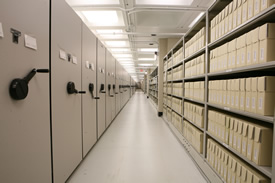
Compact moveable shelving, NY State Archives, Albany, NY
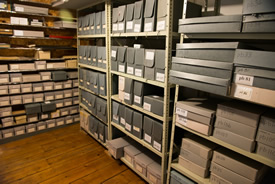
Static shelving, Saratoga County Historical Society, Ballston Spa, NY
While stabilizing the environment in your storage room will produce the largest benefit for the long-term preservation of your collections, appropriate storage furniture also dramatically improves preservation.
Storage furniture
When selecting shelving for historical follow several general guidelines.
- Historic materials should be stored on shelving capable of supporting the weight and size of your records.
- Your storage furniture should not contribute to the deterioration of the materials by off gassing harmful chemicals or otherwise reacting with your records.
- Your storage furniture should provide ample space for your records and allow for good air circulation in your storage area.
- The bottom shelf should be a minimum of 4-6 inches off the ground to protect your records from water damage in case of a minor flood.
- Your storage furniture should be located away from outside walls.
Eighteen gauge steel shelving with a powder coated finish is the ideal option for storing historical records. Oversize material should be stored in similarly constructed flat file drawers. With adequate preparation you can use wire rack shelving, and even properly sealed wooden shelving without harming historical records. Chrome plated wire rack shelving is a safe option for records storage but the shelves should be lined to prevent them from physically damaging materials. Wood emits certain acids that will harm your records and is not a good option for storing historical materials. Closed wooden shelving that concentrates those emissions in a small space is especially dangerous to historical materials. While limited resources may require you use wooden shelving it should be sealed using latex paint or water borne polyurethane. If you have wooden shelving you intend to seal contact a preservation specialist for information about specific coatings and their applications.
Weight is also an important consideration when selecting storage furniture. It is important to make sure that your building can support the weight of your shelving and the records they hold. High density shelving systems increase the quantity of records you can store in your facility but also place greater stress on your building.
Benefits
- Appropriate shelving protects your historical records from physical stress or damage
- Appropriate shelving protects your staff from shifting or falling boxes and facilitates good ergonomic practices when lifting heavy boxes.
Standards and Best Practices
- International Council on Archives Shelving for Archival Storage-Key Issues
- Northeast Document Conservation Center Storage Furniture: A Brief Review of Current Options
- Michele F. Pacifico and Thomas P. Wilsted Archival and Special Collections Facilities: Guidelines for Archivists, Librarians, Architects and Engineers Society of American Archivists (2009)
Storage Enclosures
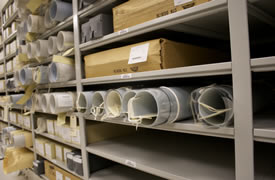
Rolled storage of oversize documents, NY State Archives, Albany, NY
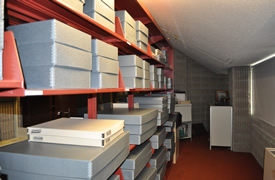
Oversize items in flat boxes, Niagara Falls Public Library, Niagara Falls, NY
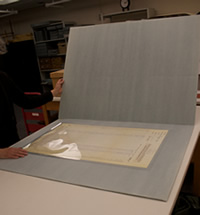
Polyester enclosures for fragile documents, NY State Archives, Albany, NY
In addition to storing historical records on stable shelving in a controlled environment it is important to house your records in appropriate containers and enclosures. Archival enclosures provide physical support, slow down chemical deterioration and provide basic protection for historic documents.
Archival storage containers and enclosures should be acid-free and (with some exceptions) buffered with alkaline materials to neutralize acids that develop over time. In addition to slowing the damage from acidity, archival quality folders and boxes protect records from light, moisture, dirt and physical damage.
Store paper records vertically in preservation quality document boxes. Preservation quality enclosures are readily available from a number of vendors who cater to historical records repositories. While many storage enclosures claiming to be ‘archival quality’ are readily available in retail stores, they do not meet professional standards and you should avoid using them to house your collections. Your folders and boxes should match the size of the records stored in them. Do not fold legal sized records to fit into letter sized containers, or store letter size folders in larger boxes. Any spaces in your boxes should be filled with supports to keep records from curling. Boxes with bulging sides are too full and should be divided into two separate boxes. Do not use rubber bands, paper clips and staples to fasten historical records together.
While most items in your collection will fit into standard legal or letter sized containers certain materials will not easily fit into regular documents boxes. Oversize materials such as maps and blueprints should be stored in oversized folders in flat files or shallow flat boxes. You may encounter oversize materials that are too large to fit in standard flat files or boxes. Rather than fold or trim these items to fit into your flat files roll them around the outside of preservation quality 4 inch diameter tubes and store them on your shelves. Contact a conservator or preservation specialist if you find you need help with housing unusual items in your collection.
Items in your collection that are fragile, brittle, torn, or frequently handled may require additional support. House these materials in plastic enclosures made of polyester, polyethylene, or polypropylene film. Make sure any plastic enclosures you use are free from plasticizers, dyes or coatings.
Ideally, items in your collection are housed in two levels of preservation quality materials appropriate for their format and condition (e.g. box and folder or folder and drawer). Unfortunately preservation quality supplies can be expensive and budget constraints may limit your ability to provide ideal storage enclosures. If this is the case, focus your resources on enclosures that come in direct contact with the records (e.g. folders, plastic sleeves, envelopes etc). You can pursue incremental improvements in document boxes and flat files as part of your long-term planning.
Benefits
Preservation quality enclosures:
- Protect your records from physical damage, exposure to light, dust, and moisture.
- Slow the effects of chemical deterioration from acid that forms in your documents
- Protect fragile items from damage during handling
Standards and Best Practices
- DHPSNY Housing Materials Basics webinar
- National Archives Holdings Maintenance
- Northeast Document Conservation Center Storage Enclosures for Books and Artifacts on Paper
- Northeast Document Conservation Center Storage Solutions for Oversized Paper Artifacts
- Canadian Conservation Institute CCI Notes: Encapsulation
- Canadian Conservation Institute Preventive Conservation and 10 Agents of Deterioration
- STASH: Storage Techniques for Art Science and History
Handling
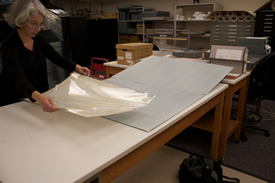
Provide adequate space and support when handling oversize materials. NY State Archives, Albany, NY.
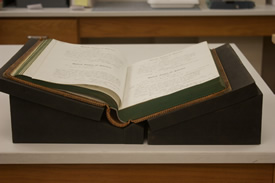
Book supports prevent damage to bindings of bound volumes. NY State Archives, Albany, NY.
Staff and researchers should be trained in the proper care and handling of historical records. If you have especially valuable or fragile items in your collection consult a professional conservator for recommendations on how best to store and handle them.
Before handling historical records consider the following questions:
- Is the document in good condition?
- Do the records need special supports?
- Is there ample space for the records?
- Are my hands clean?
Lay paper records flat on a clean desk or table when using them. Make sure oversize materials such as maps or blueprints are properly supported and do not hang over the edges of the table. Never open ledgers or other bound volumes flat on a table. Place supports under the front and back covers to maintain a comfortable angle for the binding.
Staff and researchers working with collections should only use pencils to take notes. Pens can leak, and ink can smudge, bleed or transfer to original documents.
Finally, do not allow researchers or staff to eat, drink, or smoke in the same room as historical records. In addition to the potential for physically damaging records, food can attract pests that can harm your collections.
It is especially important to train staff and volunteers in proper handling techniques. In general staff should copy materials for patrons in order to avoid damaging bindings, or harming fragile documents. Researchers are increasingly using digital cameras to copy materials while consulting them in your reading room. Before you let researchers use digital cameras in your reading room ensure they follow established guidelines such as no flash photography and adhere to intellectual property laws.
Following a few simple handling procedures that do not involve developing special skills or making large expenditures can actually save you money by preventing damage that would require expensive repairs.
Benefits
Good handling procedures:
- Protect your records from deterioration and physical damage.
- Protect staff and researchers when handling wet or moldy documents
- Prevent the need for expensive conservation treatments
Standards and Best Practices
- Northeast Document Conservation Center Storage Methods and Handling Practices
- Library of Congress Care Handling and Storage of Works on Paper
- UK National Preservation Office Managing the Preservation of Library and Archive Collections in Historic Buildings
Conservation
You may have materials in your collection that are especially valuable, are damaged, or are inherent vice and need specialized care to ensure their long-term preservation. Do not undertake complicated treatments yourself. Repairing damaged records, and stabilizing fragile materials requires advanced training. If you attempt to treat unstable historical materials without adequate training you can irreversibly damage your collections. Instead hire a conservator to treat and stabilize these items. Conservators are individuals with advanced training in the repair and stabilization of historic materials. Conservation treatments for individual items can be expensive and should be reserved for the most valuable or unstable items in your collection.
Although the core work of conservators is reversing or arresting damage to historical materials, they are also a valuable source of preservation information including recommendations for collection storage, handling and exhibition. Having a relationship with a conservator is especially helpful during disaster planning and recovery when he or she can provide recommendations for preventing and recovering from disasters.
Because you are entrusting valuable or fragile materials to a conservator’s care, you should thoroughly examine his or her qualifications and training, solicit references, and if possible, visit his or her studio. The American Institute for Conversation provides an online listing of conservators in your area that are qualified to treat a range of historical materials.
Benefits
- Ensures records with unique value or records in unstable formats are preserved and available for use.
- Provides expert advice on preservation and handling of collections
- Assists with disaster planning and recovery
Standards and Best Practices
- American Institute for Conservation "Find a Professional"
- American Institute for Conservation "Hiring a Conservation Professional"
- NEDCC “Choosing and Working with a Conservatory”
- American Institute for Conservation “Code of Ethics”
